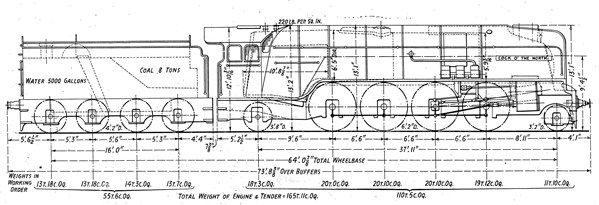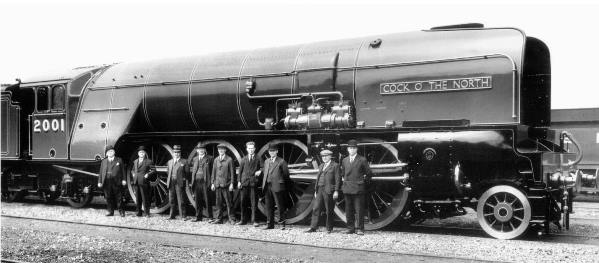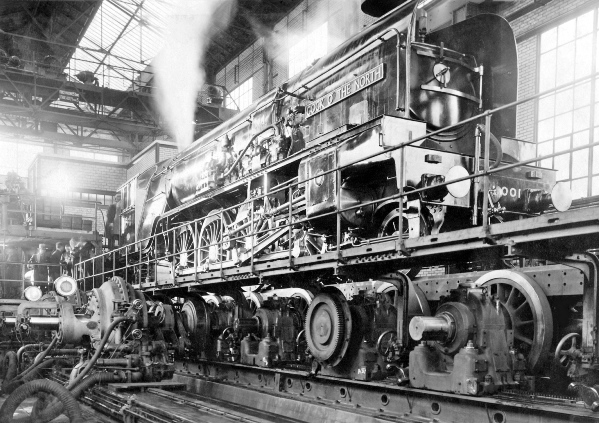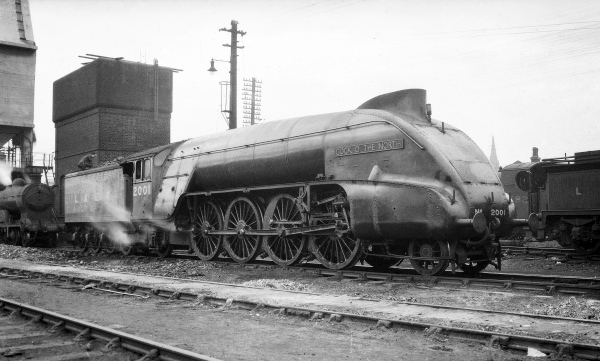In February 1933 the LNER authorised construction of two new locomotives for use on the Edinburgh to Aberdeen expresses. Subsequently known as the P2 class the order was later revised to just one locomotive. The frames were cut and laid in February 1934 with construction of the rest of the locomotive following quickly under Gresley’s direction. On the 22nd May 1934 Cock o’ the North rolled out of Doncaster works. The new locomotive was unlike anything seen before and was the first 2-8-2 express passenger locomotive to be built in the UK. Built with Lentz rotary cam poppet valves, a double chimney and Kylchap blast pipe, ACFI feed water heater and semi streamlined front end and cab. It was coupled to a standard design of tender as fitted to the LNER Pacifics. The tender however was the first to feature and all welded tender tank supplied by Metropolitan Vickers. The engine was also fitted with a Crosby chime whistle that had been presented to Gresley some years before. The locomotive soon commenced running in trials and the opportunity was taken to display the locomotive around the LNER railway system. The official press launch took place at King’s Cross on the 1st June 1934 and in the following few days the locomotive was displayed at Ilford, Aberdeen and Edinburgh with people flocking to see the new locomotive.

With running in completed the locomotive undertook test runs with the railways dynamometer car. On 19th June the engine took a test train of 19 carriages totalling 649 tons from King’s Cross to Barkston and back. During the testing the results showed a maximum of 2,100 horsepower at the drawbar making it the most powerful express locomotive in Britain. The maximum speed obtained during the test was 76mph. On other tests higher speeds were attained with the locomotive reaching the mid 80s. With testing completed the locomotive was transferred to Haymarket shed on the 31st July 1934 and entered traffic over the route of which it was designed. The engine gained much local and national interest with many of the famous railway authors of the time traveling to see and ride on the locomotive. A brief trip to Doncaster was made in August 1934 for the fitting of tablet catching apparatus to make working the single line seion of the route easier, with a return north to Scotland soon after.

Cock ‘o the North at Doncaster in 1934 with Nigel Gresley and the design team – P2SLC Collection
Gresley had always been an advocate of a locomotive testing station in the UK and had built up a friendship with Andre Chapelon who had inspired some of the design for No. 2001. As soon as the locomotive was complete Gresley entered a dialogue with Chapelon about the possibility of testing No. 2001 on the stationary test plant that had recently opened in France, the LNER not having one of their own and the only other in the UK not being capable of taking such a large locomotive. In November 1934 the engine was sent to Doncaster Works ready for preparation for its trip to the Vitry test plant near Paris. A few modifications were made, including the removal of the infinitely variable cams fitted to the locomotive as built and replaced by stepped cams giving only pre-determined positions of cut-off.

No. 2001 on the test plant at Vitry – P2SLC Collection
The locomotive left for France via the Harwich train ferry on the 4th December 1934 and arrived in Paris the following day. Testing commenced straight away with a Doncaster crew working the locomotive and Doncaster engineers observing the tests. Some problems were found with the axleboxes and these were modified in the Paris workshops and test continued. The opportunity was also taken to find the best blast pipe nozzle settings. The results obtained from the testing were as expected by the LNER engineers although not as good as the French pacific locomotives also undergoing test. The opportunity was also taken to test the locomotive on the French railway system, again with good results although at times maintain steam pressure was a problem. The French crew suggesting a larger firehole door and a bigger shovel would go some way to solving the problem. Prior to the engine returning to the UK the engine was cleaned up and placed on display at Paris Gare du Nord in company with a French pacific on the 17th February 1935.
On its return from France on the 21st February 1935 the locomotive once again retuned to Haymarket shed and continued to work the Scottish expresses. On the 30th September 1937 the locomotive was withdrawn from traffic and sent to Doncaster for rebuilding as a streamlined locomotive as per the second batch of P2 locomotives. The engine also lost its Lentz valve gear and ACFI feed water heater in favour of the traditional Walschaerts valve gear and a traditional injector. The engine returned to traffic on the 14th April 1938 and returned to Haymarket shed. The engine continued to put in good work in Scotland, returning to either Cowlairs or Doncaster work as required for attention. The only major work carried out being a new middle connecting rod and some minor boiler repairs during 1938. Although other members of the class suffered from broken crank axels and broken crank pins No. 2001 seemed to escape from any of those problems, although it did suffer from overheating bearings like its sister engines.

Cock o’ the North rebuilt with an A4 type front end and Walschaerts valve gear – P2SLC Collection
With Gresley’s death the new LNER CME Edward Thompson looked into trying to standardise the locomotive fleet and the P2 class were earmarked for rebuilding as Pacifics. The rebuilds were controversial and sparked much debate. The ungainly appearance was not popular with the staff and public alike and the locomotives rode badly prompting complaints from the crews. However, as Pacifics, the problems that had plagued the class disappeared, sacrificing power instead. No. 2001 was returned to Haymarket shed in September 1944. In August 1946 the locomotive was renumber No. 501 and again in May 1948 the locomotive was renumbered No. 60501 under the new British Railways numbering system. New problems started to appear on the class including the serious faults of cylinder blocks working loose. No. 60501 stayed in Scotland until 27th November 1949 when the locomotive was transferred to York. The locomotives were found to be unsuitable for work in Scotland as Pacifics and an attempt was made to find more suitable work south of the border. Problems continued plague the locomotives and the locomotive was eventually withdrawn at Doncaster shed on 22nd January 1960 and cut up the following month. Following its rebuild the locomotive had been into the works 26 times for repairs and overhauls. In its entire working life Cock o’ the North completed almost 980,000 miles in traffic.